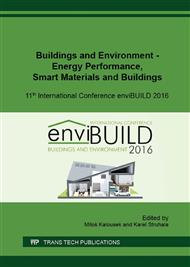[1]
R. Wai Ki Wu, M. Horvat, Simulation Study of Building Envelope Performance Using Microclimatic Meteorological Data, In: International High Performance Buildings Conference, Purdue, 2010, pp.1-8.
Google Scholar
[2]
M. Beccali, I. Bertini, G. Ciulla, B. Di Pietra, V. Lo Brano, Software for weather databases management and construction of reference years, In: Proceedings of Building Simulation 2011: 12th Conference of International Building Performance Simulation Association, Sydney, 2011, pp.1182-1186.
Google Scholar
[3]
STN EN ISO 15927-4: Hygrothermal performance of buildings. Calculation and presentation of climatic data. Part 4: Hourly data for assessing the annual energy use for heating and cooling, Slovak Office of Standards, Metrology and Testing, Bratislava, (2006).
DOI: 10.3403/30114395
Google Scholar
[4]
W. S. Cleveland, S. J Devlin, Locally Weighted Regression: An Approach to Regression Analysis by Local Fitting, J. Am. Stat. Assoc. 83 (1988) pp.596-610.
DOI: 10.1080/01621459.1988.10478639
Google Scholar
[5]
Information on: https: /www. google. com.
Google Scholar
[6]
Climate atlas of Slovakia, Bratislava, 2015. [CD-Rom].
Google Scholar
[7]
P. Juras, R. Ponechal, Measurement of lightweight experimental wall and comparison with different simulation programs, Appl. Mech. Mater. 820 (2016) pp.262-269.
DOI: 10.4028/www.scientific.net/amm.820.262
Google Scholar
[8]
Information on http: /www. esru. strath. ac. uk/publications. htm.
Google Scholar
[9]
M. Vertal, P. Durica, Bestimmung von Feuchtetechnischen Materialparametern ausgewahlter Baumaterialien fur die rechnerische Bewertung von Baukonstruktionen unter den Bedingungen in der Slowakei, Bauphysik 31 (2009) pp.386-392.
DOI: 10.1002/bapi.200910050
Google Scholar
[10]
M. Cekon, M. Kalousek, J. Hraska, Verification of MZELWE module in ESP-r program with experimental confrontation, In: Research and Applications in Structural Engineering, Mechanics and Computation, Taylor&Francis Group, Cape Town, 2013, pp.649-650.
DOI: 10.1201/b15963-328
Google Scholar
[11]
P. Juras, P. Durica, Influence of wind direction on wind-driven rain load as boundary condition for HAM simulation on high rise buildings with usage of traditional cement-lime coatings, In: Proceedings of BS2015: 14th Conference of International Building Performance Simulation Association, Hyderabad, 2015, pp.842-849.
DOI: 10.26868/25222708.2015.2339
Google Scholar
[12]
I. Pobocikova, Z. Sedliackova, J. Simon, Statistical analysis of wind speed data based on Weibull and Rayleigh distribution, Communications: Scientific letters of the University of Zilina Vol. 16 (2014) pp.136-141.
DOI: 10.26552/com.c.2014.3a.136-141
Google Scholar
[13]
K. Orehounig, E. M. Doppelbauer, A. Mahdavi, W. Loibl, T. Totzer, Climate change, Building design and thermal performance In: Proceedings of Building Simulation 2011: 12th Conference of International Building Performance Simulation Association, Sydney, 2011, pp.750-756.
DOI: 10.1080/19401491003763378
Google Scholar
[14]
A. N. Celik, Analysis of Ankara's Exposure to Solar Radiation: Evaluation of Distributional Parameters Using Long-Term Hourly Measured Global Solar Radiation Data, Turkish J. Eng. Env. Sci. 30 (2006) pp.115-126.
DOI: 10.2298/tsci0704125d
Google Scholar
[15]
J. Clemens, Entwicklung eines einfachen Modells zur Abschätzung der sommerlichen Überwärmung in Gebäuden, (2000).
Google Scholar
[16]
I. Csaky, F. Kalmar: Effects of solar radiation asymmetry on buildings' cooling energy needs, J. Build. Phys. 40 (2016) pp.35-54.
Google Scholar


